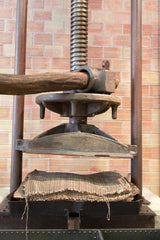Our olives are harvested from November to March with certain varietals ripening sooner than others. The weather during the months leading up to the harvest season determines exactly when the olives are ready.
The olives are harvested using several different types of automated machinery, but most of the labor is done manually. First, several tarps are layered around each individual olive tree. Next, a machine shakes the trees and branches, causing the olives to fall to the tarps. The olives that fall into these tarps are collected and any olives that fall to the ground are discarded, including those that fell naturally prior to harvest. This is very important to the production of high-quality, low-acidity, nutrient-rich olive oil. Olives that have fallen to the ground have higher acidity levels and yield low-quality olive oil.

The olives from the tarps are placed into large plastic bins that can hold approximately 2,000 lbs of olives. The olives are immediately taken to an olive oil production facility, where the olives are pressed within 24 hours, and in many cases, within 4 hours.
The olives are weighed, cleaned, weighed again, cleaned again, crushed, de-pitted, and then weighed again before the oil extraction process begins. Extraction is done by way of a centrifugal force, using a high-speed machine that separates the oil from other juices. The oil is captured in a repository, where it is weighed once again, and then transferred to a stainless steel storage container. Individual farmers are compensated based on the amount of oil that their olives produce, so weight is very important to everyone in the olive oil production process.
The entire process is done with painstaking attention to detail, at all times keeping the quality and freshness of the oil as the primary goal.
The oil is maintained in storage containers until it is transferred to individual bottles.